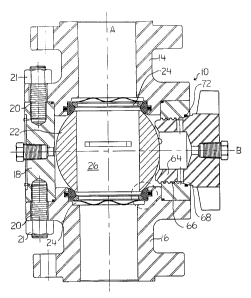Some of the information on this Web page has been provided by external sources. The Government of Canada is not responsible for the accuracy, reliability or currency of the information supplied by external sources. Users wishing to rely upon this information should consult directly with the source of the information. Content provided by external sources is not subject to official languages, privacy and accessibility requirements.
Any discrepancies in the text and image of the Claims and Abstract are due to differing posting times. Text of the Claims and Abstract are posted:
| (12) Patent: | (11) CA 2161396 |
|---|---|
| (54) English Title: | PIG INJECTOR |
| (54) French Title: | INJECTEUR EN FONTE BRUTE |
| Status: | Expired |
| (51) International Patent Classification (IPC): |
|
|---|---|
| (72) Inventors : |
|
| (73) Owners : |
|
| (71) Applicants : |
|
| (74) Agent: | LAMBERT INTELLECTUAL PROPERTY LAW |
| (74) Associate agent: | |
| (45) Issued: | 2004-12-28 |
| (22) Filed Date: | 1995-10-25 |
| (41) Open to Public Inspection: | 1997-04-26 |
| Examination requested: | 2000-05-30 |
| Availability of licence: | N/A |
| (25) Language of filing: | English |
| Patent Cooperation Treaty (PCT): | No |
|---|
| (30) Application Priority Data: | None |
|---|
A pig injector has a valve assembly having
a pair of valve seats. A valve ball having a bore is
disposed within the valve assembly and seated on the
valve seats. A journalled stem mounted in a stuffing
box is provided to rotate the valve ball within the
valve assembly between a position in which the bore is
aligned along the pipe and a position in which the
bore is aligned across the pipe. A side entry cap is
disposed in the valve assembly in alignment with the
bore of the valve ball when the bore is aligned across
the pipe. The side entry cap includes a threaded
portion and a sealing portion, the threaded portion
being cylindrical and the sealing portion having an
exterior surface forming a conical section increasing
in diameter with increasing distance from the bore of
the valve ball. The valve assembly has a corresponding
conical seat portion for receiving the conical section
of the side entry cap in sealing relationship. An
annular groove is formed in one of the conical section
of the sealing portion and the conical seat portion of
the valve assembly, the annular groove being defined
by walls extending inward from the respective one of
the conical section of the sealing portion and the
conical seat portion of the valve assembly. An annular
sealing element is disposed within the annular groove.
Injecteur à racleur ayant un ensemble de valve comprenant une paire de sièges de valve. Un clapet ayant un alésage est disposé au sein de lensemble de valve et siège sur les sièges de valve. Une tige tourillonnée montée dans une boîte à garniture est prévue pour faire tourner le clapet au sein de lensemble de valve entre une position dans laquelle lalésage est aligné le long du tuyau et une position dans laquelle lalésage est aligné en travers du tuyau. Un capuchon dentrée latérale est disposé dans lensemble de valve en alignement avec lalésage du clapet lorsque lalésage est aligné en travers du tuyau. Le capuchon dentrée latérale inclut une portion filetée et une portion détanchéité, la portion filetée étant cylindrique et la portion détanchéité ayant une surface extérieure formant une section conique dont le diamètre augmente avec la distance par rapport à lalésage du clapet. Lensemble de valve comprend une portion de siège conique correspondante destinée à recevoir la section conique du capuchon dentrée latérale en relation détanchéité. Une rainure annulaire est formée dans un élément parmi la section conique de la portion détanchéité et la portion de siège conique de lensemble de valve, la rainure annulaire étant définie par des parois sétendant vers lintérieur depuis lélément respectif parmi la section conique de la portion détanchéité et la portion de siège conique de lensemble de valve. Un élément détanchéité annulaire est disposé au sein de la rainure annulaire.
Note: Claims are shown in the official language in which they were submitted.
Note: Descriptions are shown in the official language in which they were submitted.

For a clearer understanding of the status of the application/patent presented on this page, the site Disclaimer , as well as the definitions for Patent , Administrative Status , Maintenance Fee and Payment History should be consulted.
| Title | Date |
|---|---|
| Forecasted Issue Date | 2004-12-28 |
| (22) Filed | 1995-10-25 |
| (41) Open to Public Inspection | 1997-04-26 |
| Examination Requested | 2000-05-30 |
| (45) Issued | 2004-12-28 |
| Expired | 2015-10-26 |
There is no abandonment history.
Note: Records showing the ownership history in alphabetical order.
| Current Owners on Record |
|---|
| ARGUS MACHINE CO. LTD. |
| Past Owners on Record |
|---|
| ELLETT, JAMES RICHARD |